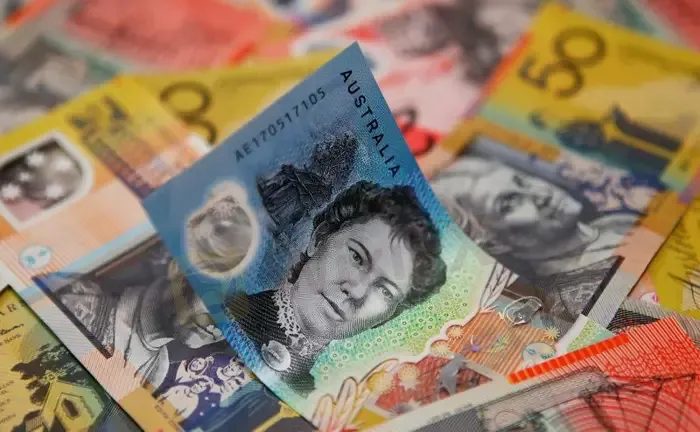简体中文
繁體中文
English
Pусский
日本語
ภาษาไทย
Tiếng Việt
Bahasa Indonesia
Español
हिन्दी
Filippiiniläinen
Français
Deutsch
Português
Türkçe
한국어
العربية
Aussie, kiwi fall as China’s recovery falters; yuan eases on surprise PBOC rate cut
Abstract:The risk-sensitive Australian and New Zealand dollars retreated from near two-month highs against the greenback on Monday due to dissappointing data from China, a key trading partner, while the Chinese yuan weakened after a surprise cut in interest rates.

The greenback edged higher as traders continued to weigh data that has raised the possibility that U.S. inflation may be peaking against Federal Reserve policymakers hawkish comments.
The U.S. dollar index, which gauges the currency against six major peers, edged 0.07% higher to 105.77, consolidating near the middle of its range this month.
The onshore yuan eased to a one-week low against the dollar after the PBOC unexpectedly cut key interest rates. It weakened to a low of 6.7620 per dollar, compared with the previous close of 6.7430.
New Zealand‘s kiwi slumped 0.35% to $0.6433, pulling away from Friday’s high at $0.6468, the strongest level since June 8.
The Australian dollar slid 0.27% to $0.7102, falling further away from the recent peak last Thursday, when it struck it highest level since June 10 at $0.7136.
Chinese industrial output, retail sales and fixed-asset investment all fell short of analyst estimates, as a nascent recovery from COVID-19 lockdowns faltered.
To support the economy, the Peoples Bank of China (PBOC) unexpectedly cut a key interest rate for the second time this year and withdrew some cash from the banking system on Monday.
The PBOC said it was lowering the rate on 400 billion yuan ($59.33 billion) of one-year medium-term lending facility (MLF) loans to some financial institutions by 10 basis points (bps) to 2.75%, from 2.85%.
It also injected 2 billion yuan through seven-day reverse repos while cutting the borrowing cost by the same margin of 10 bps to 2.0% from 2.1%, according to an online statement.
“Despite the warning of inflation risk and flush liquidity conditions, the dominant downside risks from the COVID spread and property-sector rout prompted the PBOC to cut rates to stimulate demand,” said Ken Cheung, chief Asian FX strategist at Mizuho Bank.
U.S. data on Friday showing the first decline in import prices for seven months followed statistics earlier in the week that showed consumer and producer prices also cooling.
That has fueled investor hopes for less aggressive Fed tightening, despite a continued chorus of hawkish Fed rhetoric, with Richmond Fed President Thomas Barkin telling CNBC on Friday that he would like to see inflation running at the Fed‘s 2% target for “some time” before stopping rate hikes, adding there’s “still more to come to get into restrictive territory.”
Analysts will scour minutes of the Fed‘s most recent meeting, due to be released on Wednesday, for more clues on policymakers’ thinking, while retail sales data on Friday will give some fresh insight on the economys health.
“A growing narrative of a soft landing has taken hold, gaining traction after some easing in price indicators, with some interpreting that as allowing the Fed to ease up on the pace of hikes,” Tapas Strickland, a markets economist at National Australia Bank, wrote in a client note.
The minutes are a risk though, and “may push back on the notion of a Fed pivot,” Strickland said.
Money markets now price 44.5% odds of another 75 basis-point rate hike by the Federal Open Market Committee in September, versus 55.5% probability of a slowing in the pace of tightening.
The euro eased 0.1% to $1.02455, weighed down by Europes struggles with the war in Ukraine, the hunt for non-Russian energy sources and a hit to the German economy from scant rainfall.
Sterling slipped 0.18% to $1.21135.
Against the yen though, the dollar sank 0.27% to 133.24 amid an easing in U.S. Treasury yields.
Leading cryptocurrencies bitcoin and ether rose back toward more than two-month peaks.
Bitcoin last rose 2% to $24,813, bringing it close to Sundays high of $25,053, a level not seen since June 13.
Smaller rival ether gained 2.94% to $1,993.70, approaching Sundays peak of $2,031.56, the highest since May 23.
Ethereum‘s long-awaited “merge” upgrade appears all but certain to happen in September, promising a 99.95% reduction in the blockchain’s energy consumption and preparing it for faster transactions after years of delays.

Disclaimer:
The views in this article only represent the author's personal views, and do not constitute investment advice on this platform. This platform does not guarantee the accuracy, completeness and timeliness of the information in the article, and will not be liable for any loss caused by the use of or reliance on the information in the article.
Read more

The Daily Habits of a Profitable Trader
Every professional trader follows a structured approach to ensure they are well-prepared, disciplined, and able to seize opportunities with confidence. Whether you are a seasoned investor or an aspiring trader, adhering to a robust daily checklist can significantly enhance your performance. Use this checklist to check if you are a qualified trader

The Impact of Interest Rate Decisions on the Forex Market
Interest rate changes determine currency attractiveness, influencing capital flows and exchange rate trends. Understanding this mechanism helps investors navigate the forex market effectively.

How a Housewife Lost RM288,235 in a Facebook Investment Scam
A 47-year-old housewife in Malaysia recently fell victim to an online investment scam, losing a substantial sum of RM288,235 after engaging with a fraudulent scheme advertised on Facebook.

A Trader’s Worst Mistake: Overlooking Broker Reviews Could Cost You Everything
In today’s digital age, reviews influence nearly every decision we make. When purchasing a smartphone, television, or home appliance, we pore over customer feedback and expert opinions to ensure we’re making the right choice. So why is it that, when it comes to choosing an online broker where real money and financial security are at stake many traders neglect the crucial step of reading reviews?
WikiFX Broker
Latest News
The Withdrawal Trap: How Scam Brokers Lure Victims into Paying More
FCA to Investors: Think Twice Before Trusting These Brokers
Trump\s tariffs: How could they affect the UK and your money
Trump gambles it all on global tariffs he\s wanted for decades
TradingView Brings Live Market Charts to Telegram Users with New Mini App
Trump tariffs: How will India navigate a world on the brink of a trade war?
Interactive Brokers Launches Forecast Contracts in Canada for Market Predictions
Authorities Alert: MAS Impersonation Scam Hits Singapore
IG Group Acquires Freetrade for £160M to Expand UK Investment Market
U.S. March ISM Manufacturing PMI Released
Currency Calculator







